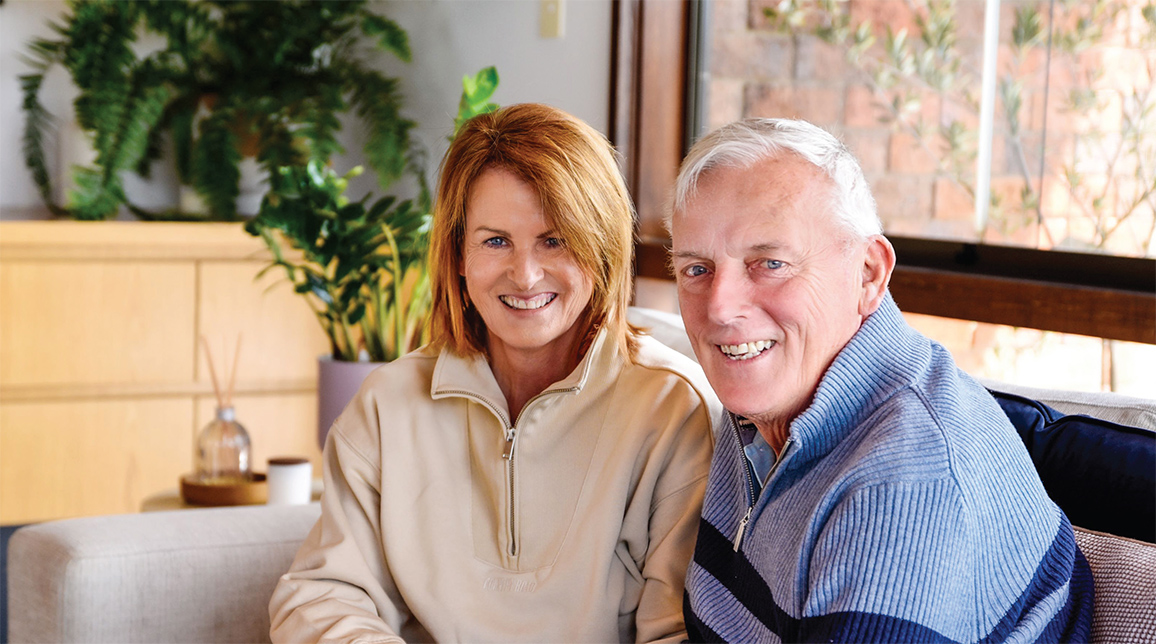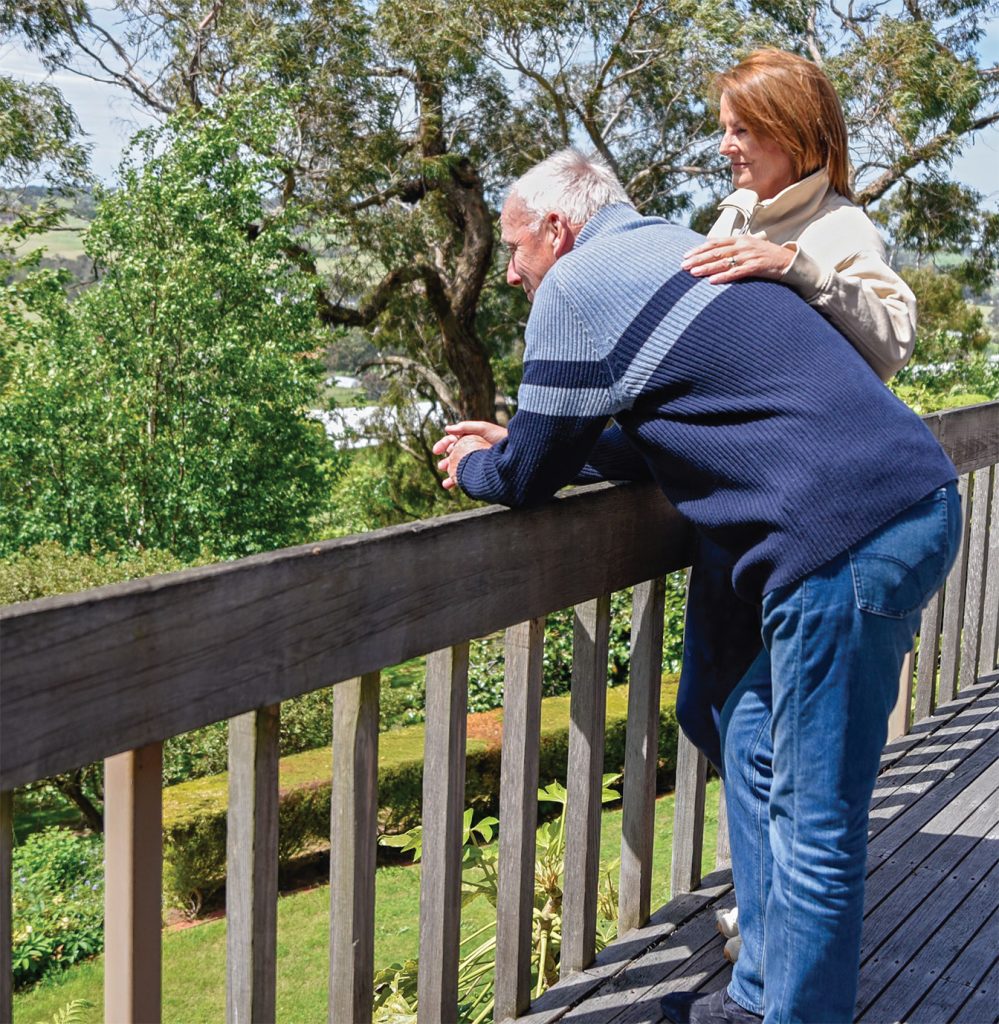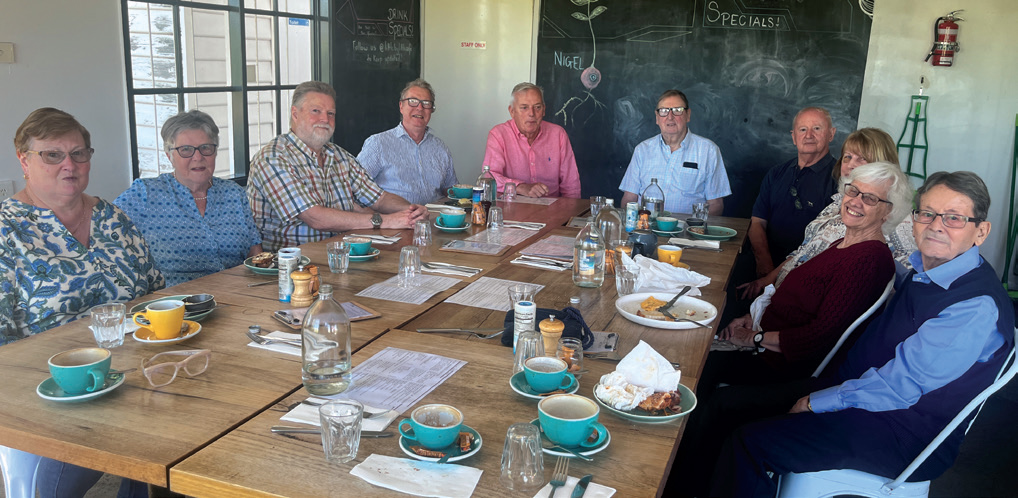Community of Hope

As veteran sports commentator Sandy Roberts recovered from open heart surgery in 2022, he felt as fit and healthy as ever – so it came as a real shock when he was diagnosed with cancer just three months later.
The revelation came after he was knocked for six in a couch-moving incident at his Melbourne home. ‘The doctor came in and said, “You’ve
got two broken ribs, your internal bleeding will be fine, and you’ve got cancer’ – just like that,’ Sandy recalls.
Myeloma – also known as multiple myeloma – is a cancer that forms in the bone marrow, the spongy material found in the middle of the bigger bones of the body. This is where most of your blood cells are made, as well as plasma – the liquid part of blood, and an integral part of the immune system. It is these plasma cells that are affected by myeloma. Symptoms can include bone pain and fractures, fatigue, frequent infections, kidney damage and high levels of calcium in the blood. However, the disease may be present for some time without causing noticeable or easily recognised symptoms, and many people find out by accident, as Sandy did\
In fact, when Sandy went in for his heart procedure, there was no inkling that anything else was amiss. Scanning Sandy’s broken ribs after the accident, doctors picked up the presence of lesions in his back; they had also developed in his pelvis. This was the clue that led to Sandy’s shock diagnosis.
A NEW NORMAL
At first, Sandy struggled to accept his diagnosis. Carolyn took it upon herself to learn as much as she could about the illness, as well as what supports are available for patients and carers. This was how she became linked in with Myeloma Australia, a not-for-profit organisation dedicated to supporting, empowering and advocating for myeloma patients and those who care for them. Carolyn found comfort and
practical advice talking to Myeloma Australia’s team of dedicated nurses. The organisation also facilitate local support groups, which is how Sandy and Carolyn discovered a group who meet together in Berwick.
‘It got a lot easier,’ Carolyn recounts. ‘Certainly, early on when Sandy was first diagnosed, I felt hopeless. In all honesty, Myeloma Australia and the support group have given us hope. [Myeloma] is not curable, but it is treatable. We’ve learned to enjoy life.’ Sandy says, ‘You come away from the meetings with a positive feeling; there’s hope.’ But it’s not just about the support they receive: the pair have become fierce advocates for increased awareness and funding for myeloma research, as well as being an integral part of the tight-knit support group. ‘It becomes an overwhelming thing,’ Carolyn says. ‘You want to help others as well.’
For the most part, Sandy says he doesn’t feel unwell, but he knows that he is more vulnerable to injury and illness. ‘I’m not as strong as I was. I’m more careful; I can’t afford to have a fall. [Myeloma] affects the immune system. You’re not protected by your immune system – you can catch anything.’ Most of the physical symptoms Sandy experiences actually come from the chemotherapy medicines used to treat myeloma, a combination of Velcade, Revlimid and Dexamethasone. Each can cause a range of uncomfortable side effects that can impact a person’s quality of life. ‘Treatment is hard,’ Sandy admits. ‘The drugs are challenging.’
FUTURE UNCERTAIN
At the time of writing, Sandy is in remission from myeloma – but this is not quite as hopeful as it sounds. For reasons yet to be uncovered, myeloma comes back in as many as 90 months. For now, Sandy continues to see his haematologist every six weeks for testing to make sure the cancer has not returned.
ADVERTISING
QUICK FACTS
ABOUT MYELOMA
- Over 20,000 Australians have myeloma and 50 new patients are diagnosed every week.
- While myeloma primarily affects people aged over 60, it can also develop in younger people, with 5-10% diagnosed under the age of 50.
- As many as 27% of people die within 18 months of being diagnosed.
- However, this figure is decreasing as treatments improve.
- According to Cancer Australia research, the 5-year survival rate is 55%; by contrast this figure is 90% for breast cancer survivors.
- Researchers don’t yet know what causes myeloma or why the remission rate is so high

However, even in remission, Sandy’s immune system remains compromised, and he lives with the damage caused to his kidneys and bones – as well as the knowledge that no one knows when he might relapse. ‘The greatest fear is the unknown. You just don’t know when it’s going to hit you.’
HOPE FOR A CURE
Mark Henderson, CEO of Myeloma Australia, has high hopes for the future of myeloma patient care. New treatments are being developed across the globe, and estimates such that within as little as 10 years, we could have an ‘operational cure’ for myeloma. That means that although doctors made never be able to fully prevent myeloma or remissions of the disease, they will be able to treat it so that patients no longer suffer from the harmful effects of the cancer.
In Australia, we are lucky to have some of the best medical and scientific researchers in the world. What’s needed now are the funds to back the research and clinical trials needed to realise the dream of a cure. It’s estimated that a cash injection of $100 million over 10 years is what’s needed to reach the goal. This figure may seem daunting, but when you consider that the Australian government has invested over $18 billion on Covid vaccines in the last three years, it starts to look more achievable.
That’s why Sandy and Carolyn have partnered with Myeloma Australia to spread awareness about the deadly disease, and to raise vital money for Myeloma Australia, which receives no government funding and relies solely on the generosity of supporters for its life changing work.
BERWICK MYELOMA SUPPORT GROUP
Cedric was diagnosed with myeloma in 2014, and has been attending the Berwick support group with wife and carer Sheila for over five years. Cedric’s treatment journey has involved three clinical trials of different drugs; he explains that one medication is effective for around 2-3 years, and then it’s necessary to try something new. Cedric says the support group has been ‘very useful to meet and exchange stories’, with Sheila adding, ‘We can think we have all these problems alone, but some of the other people have it worse, [and it makes you think], “It’s not that bad”’.
The Berwick myeloma support group has previously met at St John of God Hospital and the Old Cheese Factory in Berwick. Now the group, which receives no funding, is on the hunt for a quiet space for their meetings, which happen several times a year. Know of a venue that might fit the bill? Reach out via sam@samsmithmedia.com.au.

Left to Right: Jen Heal, Lynne Bryon, John Woodman, Malcolm Anderson, Sandy Roberts, Graeme McPherson, Frank Fras, Lorraine Fras, Sheila Wilson, Cedric Wilson
